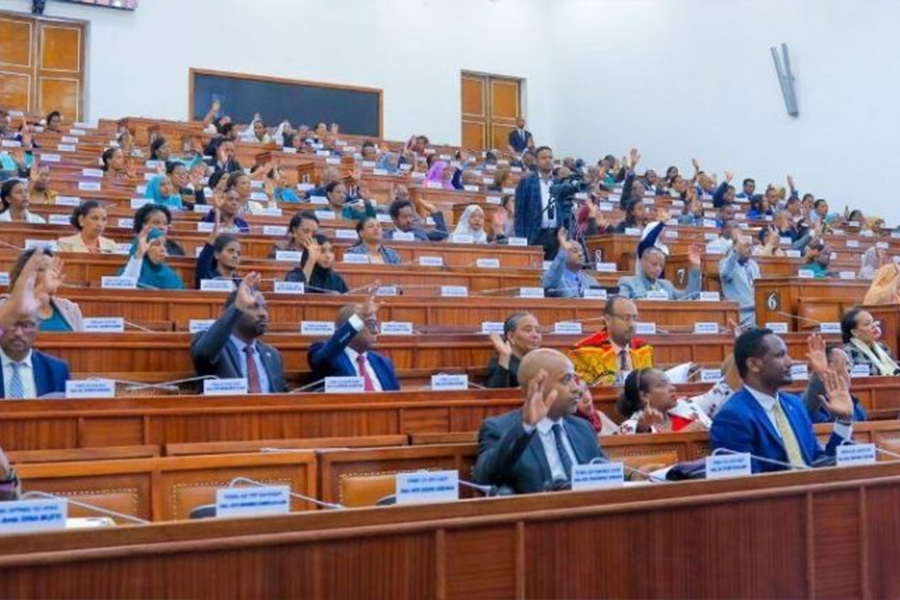
Radar | May 17,2025
Jun 20 , 2020
By Astewaye Woldemichael
The impact of COVID-19 on facility agreements has been substantial, but there are certain trends and amendments that can help mitigate the challenges, writes AstewayeWoldemichael, a legal analyst in the banking and finance department of the law firm Latham & Watkins.
In addition to being a public health crisis, no sector, business or individual has been left unaffected by COVID-19. These are unprecedented times and huge uncertainty remains as to the course the pandemic will take, both in terms of how long it will last and its long-term impact.
Most businesses face challenges during this time. Cash flow is one of the immediate key considerations for borrowers and raises concerns as to their ability to comply with their obligations under their financing arrangements. The sustainability of their capital structure is a longer-term consideration.
This is why Ethiopia’s government is reaching deep within its coffers to provide the banks with the liquidity they need to give short-term and lower interest rate loans to businesses that are struggling to retain their employees or keep themselves afloat.
When a company is facing liquidity problems, depending on the context, there are various options available to enhance liquidity. The European loan market serves as a good case study. It could defer payments to creditors and suppliers or cut costs by reducing overhead such as staff. It can also sell assets to raise capital and carve out any costs associated with those assets, raise equity investments through existing shareholders or new ones and draw full amounts of all facilities and other credit lines or incur new debt. From the outset, it may seem that companies in distress have various options available, including government interventions. However, the devil is in the details, and carrying out of these options will depend on the circumstances of each company and the governing law and provisions.
In the context of assessing options available under debt documents, the first feasible thing to do is to check the terms of all the company’s existing debt documents and see if there are options for additional liquidity without the need for lender consent.
If consent is required then the next option would be to use the route that has the least amount of condition precedents to draw under the facilities, that is, the minimum requirements that need to be satisfied to take out the loan. Normally, this would mean using any capacity that is available under its committed facilities, typically a Revolving Credit Facility (RCF) or working capital facility and to check whether the company is still able to satisfy the conditions to draw under the facilities. The former is available in Ethiopia at certain banks, usually for those in the export market.
These conditions usually entail showing that there is no possibility of default. An occurrence of an event of default gives the lender the right to accelerate the loan. There is no one-size-fits-all understanding of a default event. It entirely depends on the drafting of the clause and this varies depending on the business, market practice and jurisdiction. There are various types of default events or default clauses that might be triggered.
In the time of COVID-19, the most relevant and amended event of default provisions across the world is insolvency or insolvency proceedings. This is likely to be widely drafted and not only be triggered by an insolvency proceeding but also by a suspension of payment of a borrower of debt. It can also be triggered if the company commences negotiations with one or more of its creditors. This protects lenders by prohibiting third-party creditors from getting preferential rights to payments over the lenders.
The COVID-19 amendments seen relating to this provision allows negotiations with one or more creditors. For instance, just like negotiating with your landlord, allowing companies with decreased revenues to negotiate rental payment terms allows them to address more imminent matters. A cessation of business event is also relevant under the current circumstances. For this clause there is usually a materiality requirement. For example, cessation must relate to the entire business or a material part of it. However, with the current social distancing measures, it is certainly possible the cessation will be material. The amendments during COVID-19 usually provide that it will not be an event of default if the cessation or suspension is a direct or indirect impact of the pandemic. This includes cases where cessation resulted in response to compliance with government measures.
The litigation event of default is also important in the current circumstances. If borrowers are in financial and other difficulties, they may be subject to litigation if they breach other contracts they have entered into. Cross default comes into play if there is a default under other debt arrangements that have been entered into by the borrower or if other debts are accelerated, commitments cancelled as a result of a default or debts are declared due earlier than their maturity.
Considering the trend of companies changing their business models, for example, shifting towards manufacturing ventilators and producing sanitizers, the change of business clause is also another event of default to consider. Naturally, notice requirements need to be complied with, meaning all of these possibilities of default and changes need to be disclosed by borrowers, especially if they want to obtain waivers or amendments to avoid triggering breaches.
Outside of these strict default clauses defined in the facility agreements, there are discussions as to whether the pandemic will constitute a force majeure or merely frustrate contracts.
Force majeure clauses, which usually entitles a party to suspend or claim an extension of time following events beyond its control that make it impossible to perform the contract, are typically not included in facility agreements and, depending on the governing law, if there is no clause then none will be implied or there is already a law defining such an event. Frustration and illegality of contract clauses are also unlikely to be applied in the context of facility agreements. For new facility agreements, there have been discussions on drafting 'Corona' clauses, although there is no consistent market practice yet. This clause will enable borrowers to carve out the impact of the virus going forward, particularly in relation to any financial covenants.
In cases where there are no committed facilities available, the next step would be to assess the possibility of requesting additional facility under the loan documents and whether it would provide sufficient liquidity for the business.
Much like, and in addition to, the conditions to access committed facilities mentioned above, many loan facilities of companies will have to comply with requirements such as leveraged ratios and contracts if it is looking to incur new debt. However, how these contracts and ratios are determined depends on the terms of the debt documents and whether it is a loan document or a bond document.
For example, in dollar bond packages, there is flexibility when determining how much debt headroom the company has available. This means if a company is looking to incur debt from January to March of a given year, it would likely be using its financial results from September of the previous year to calculate its leverage ratios. However, in loan documents there are clearer limitations mainly because the management or lender would not want to allow the company to take on a huge amount of debt based on its strongest quarter, creating an unsustainable debt load and inevitably leading to a default event.
Another COVID-19 amendment allows for financial maintenance covenant relief in which borrowers are seeking temporary holidays from compliance with their financial covenants. This relief is provided for a definite period, typically for two to four quarters, however, there are cases where the contracts are removed altogether and replaced with a temporary liquidity one. For the purpose of meeting this, liquidity could take the form of cash or cash equivalents on the balance sheet and any committed but undrawn credit lines. Other amendments relate to more stringent reporting obligations (including financial information) and possibilities for additional debt and lien capacity, that is, permitting access to unsecured new sources of funding (with a cap) that have been made available by governments.
There are also key considerations relating to restructuring and insolvency from the perspective of the borrower or sponsor (in case of private equity) when there is a downturn in performance or a default situation. Assuming the company is in need of cash, the first thing to do is to understand those cash needs and determine whether the company is worth restructuring or whether it should be sold or liquidated.
If there is a little bit of headroom before insolvency, the company can make cash projections and, depending on how realistic these projections are, the borrower or sponsor can negotiate with banks or lenders on where the funds should come from. Usually, the banks ask the borrowers or sponsors to inject more equity, which, in turn, requires the banks to provide the principal, an interest holiday or an additional loan.
If the sponsor or borrower is forced to make the investment, then it should try to structure the investment or secure it. Injecting money as equity should be the last resort, and even then it is preferable to consider equity appreciation rights because they create a contractual debt claim over any future insolvency priority over pure equity claims.
While all of these are some of the relevant provisions to facility agreements that should be focused on against the backdrop of the global pandemic we are facing, it is by no means an exhaustive one. No doubt, each facility agreement and local law requirements should be carefully considered on a case-by-case basis.
PUBLISHED ON
Jun 20,2020 [ VOL
21 , NO
1051]


Agenda | Aug 08,2020

Radar | Sep 26,2021

Radar | Aug 07,2021

Viewpoints | Jan 03,2021

Commentaries | Dec 11,2020

Photo Gallery | 175486 Views | May 06,2019

Photo Gallery | 165708 Views | Apr 26,2019

Photo Gallery | 156053 Views | Oct 06,2021

My Opinion | 136824 Views | Aug 14,2021

Dec 22 , 2024 . By TIZITA SHEWAFERAW
Charged with transforming colossal state-owned enterprises into modern and competitiv...

Aug 18 , 2024 . By AKSAH ITALO
Although predictable Yonas Zerihun's job in the ride-hailing service is not immune to...

Jul 28 , 2024 . By TIZITA SHEWAFERAW
Unhabitual, perhaps too many, Samuel Gebreyohannes, 38, used to occasionally enjoy a couple of beers at breakfast. However, he recently swit...

Jul 13 , 2024 . By AKSAH ITALO
Investors who rely on tractors, trucks, and field vehicles for commuting, transporting commodities, and f...

Oct 18 , 2025
The political establishment, notably the ruling party and its top brass, has become p...

Oct 11 , 2025
Ladislas Farago, a roving Associated Press (AP) correspondent, arrived in Ethiopia in...

Oct 4 , 2025
Eyob Tekalegn (PhD) had been in the Governor's chair for only weeks when, on Septembe...

Sep 27 , 2025
Four years into an experiment with “shock therapy” in education, the national moo...

Oct 18 , 2025 . By NAHOM AYELE
In a sweeping reform that upends nearly a decade of uniform health insurance contribu...

Oct 18 , 2025 . By BEZAWIT HULUAGER
A bill that could transform the nutritional state sits in a limbo, even as the countr...

Oct 18 , 2025 . By SURAFEL MULUGETA
A long-planned directive to curb carbon emissions from fossil-fuel-powered vehicles h...

Oct 18 , 2025 . By BEZAWIT HULUAGER
Transaction advisors working with companies that hold over a quarter of a billion Bir...